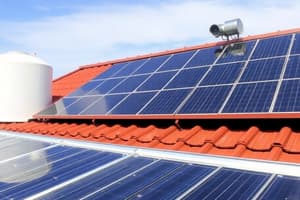Podcast
Questions and Answers
What is the primary purpose of a flat plate collector?
What is the primary purpose of a flat plate collector?
- To provide insulation against temperature changes
- To reflect sunlight away from a surface
- To harvest solar radiation to raise fluid temperature (correct)
- To trap heat through conduction processes
What is a major advantage of volumetric air collectors compared to liquid collectors?
What is a major advantage of volumetric air collectors compared to liquid collectors?
- They are less likely to corrode. (correct)
- They produce higher temperatures for heating.
- They can operate in cloudy weather.
- They require more maintenance.
What is the function of the mirrors in a solar power tower system?
What is the function of the mirrors in a solar power tower system?
- To provide shade to the surroundings
- To diffuse sunlight for better coverage
- To block sunlight from reaching the ground
- To focus sunlight onto a central receiver (correct)
Why do parabolic trough collectors need to track the sun?
Why do parabolic trough collectors need to track the sun?
What is the structure of a Fresnel collector?
What is the structure of a Fresnel collector?
What is the primary coolant used in solar thermal systems for its large thermal capacity?
What is the primary coolant used in solar thermal systems for its large thermal capacity?
What is a common type of storage system used in solar thermal applications?
What is a common type of storage system used in solar thermal applications?
How do solar cells generate electricity?
How do solar cells generate electricity?
In the p-n junction of a solar cell, which behavior characterizes the n-type region?
In the p-n junction of a solar cell, which behavior characterizes the n-type region?
What happens to the collector fluid in colder climates to prevent freezing in a solar thermal system?
What happens to the collector fluid in colder climates to prevent freezing in a solar thermal system?
What is considered a renewable energy source?
What is considered a renewable energy source?
What is the typical rate at which solar energy arrives at the earth's atmosphere?
What is the typical rate at which solar energy arrives at the earth's atmosphere?
What percentage of the sun's energy reaches the surface of the earth?
What percentage of the sun's energy reaches the surface of the earth?
What factor is essential for maximizing energy collection from solar radiation?
What factor is essential for maximizing energy collection from solar radiation?
Which type of solar thermal collector is NOT classified as a concentrating collector?
Which type of solar thermal collector is NOT classified as a concentrating collector?
Flashcards
Alternative Energy Source
Alternative Energy Source
A non-depleting or renewable energy source, such as solar or wind.
Solar Irradiance (Distribution)
Solar Irradiance (Distribution)
The amount of solar energy received at a specific location, often varying by region.
Solar Constant
Solar Constant
The average solar energy received per unit area outside Earth's atmosphere.
Solar Thermal Collector
Solar Thermal Collector
Signup and view all the flashcards
Solar Irradiance (Orientation)
Solar Irradiance (Orientation)
Signup and view all the flashcards
Flat Plate Collector
Flat Plate Collector
Signup and view all the flashcards
Evacuated Tube Collector
Evacuated Tube Collector
Signup and view all the flashcards
Concentrating Collector
Concentrating Collector
Signup and view all the flashcards
Parabolic Trough
Parabolic Trough
Signup and view all the flashcards
Solar Power Tower
Solar Power Tower
Signup and view all the flashcards
Molten Salt Coolant
Molten Salt Coolant
Signup and view all the flashcards
Solar Dish Concentrator
Solar Dish Concentrator
Signup and view all the flashcards
Thermal Storage System
Thermal Storage System
Signup and view all the flashcards
Rock-Bed Storage
Rock-Bed Storage
Signup and view all the flashcards
Water-Based Storage
Water-Based Storage
Signup and view all the flashcards
Study Notes
Chapter 9: Alternative Use of Energy
- Alternative energy sources are non-depleting or renewable energy sources.
- Examples of alternative energy sources include solar and wind power, while conventional energy sources like natural gas, coal, and oil are considered alternative at different times in history.
- Government funding and tax incentives for alternative energy research and development (R&D) decreased significantly in the 1980s and early 1990s.
9.1 Solar Thermal Systems
- This section covers solar thermal systems, including:
- Introduction
- Solar Irradiance
- Solar Thermal Collectors
- Thermal Storage Systems
Solar Irradiance (Distribution)
- The Middle East and North Africa (MENA) region receives the highest solar irradiance globally.
- Mapping of solar irradiance is used to visualize the variation of solar energy.
Solar Irradiance (Orientation)
- To maximize solar energy collection, the orientation of collectors should be perpendicular to the solar radiation.
- The angle of the sun's path over the course of a day and throughout the year affects the angle at which solar panels need to face the sun to be most effective.
Solar Irradiance (Numerical Facts)
- Solar energy arrives at Earth's atmosphere at a rate of approximately 1353 W/m² (428 Btu/hr ft²).
- This value is known as the solar constant.
- Only about two-thirds of solar radiation reaches Earth's surface due to atmospheric reflection, absorption, and scattering.
- Noontime solar radiation at 40° north latitude is typically approximately 946 W/m² (300 Btu/hr ft²) on a clear day.
Solar Thermal Collectors
- Solar Thermal Collectors are categorized into two types:
- Non-concentrating collectors:
- Flat plate collectors
- Evacuated tube collectors
- Volumetric air collectors
- Concentrating collectors:
- Parabolic Trough
- Compound Parabolic Concentrator (CPC)
- Fresnel
- Solar Power Tower
- Solar Dish Stirling Engine
- Non-concentrating collectors:
Flat Plate Collectors
- Typically used for applications requiring relatively low temperatures (below 120°C).
- The collector is usually oriented towards the south to maximize solar energy capture.
- The collector heats a fluid (like air or water) which can be used for various applications.
Evacuated Tubes (Vacuum Tubes)
- Similar in concept to flat plate collectors.
- The glass tube allows solar radiation and traps heat generated from solar radiation, preventing loss through convection.
Volumetric Air Collectors
- Offers benefits over liquid collectors, including:
- Resistance to freezing
- Less damage from leaks
- Decreased likelihood of corrosion
Parabolic Trough
- Collectors operate within a temperature range of 250–450°C.
- They use concentrating collectors that capture relatively high temperatures for applications like power generation.
- The systems need to track the precise movement of the sun to optimize radiation capture.
Compound Parabolic Concentrator (CPC)
- Uses multiple smaller flat mirrors arrayed in a specific shape to concentrate solar radiation.
- Is simpler and less costly than parabolic troughs
Fresnel collectors
- Similar to parabolic trough collectors, they use numerous flat mirrors
- A less sophisticated design, easier to maintain and cheaper than parabolic systems
Solar Power Tower
- The system uses multiple two-axis tracking mirrors to direct sunlight towards a central receiver.
- Molten salt is used as a coolant for the heat storage.
Solar Dish Concentrator
- Direct solar energy conversion occurs at the receiver.
- Uses a generator that directly produces AC power
Thermal Storage Systems
- The demand for solar energy is typically inconsistent throughout the day and throughout the year.
- System components store the captured and processed or heated solar energy output.
- Heat storage systems are an essential part of solar heating and cooling systems.
- Air-type collectors use rock beds, while water tanks are more common in liquid systems.
- Systems may need antifreeze in the event of freezing temperatures.
Solar Cells (Photovoltaics)
- Solar cells use semiconductor materials to convert sunlight directly into electricity.
- Most solar cells are made up of p-n junctions which are large areas composed of very large area of p-n junction diodes.
- Different solar cell types exist, with varying efficiencies and characteristics
Wind Energy
- Wind is a form of solar energy arising from the uneven heating of the atmosphere, irregularities of the earth, and rotation of the earth.
- Wind energy is "harvested" by modern wind turbines for electricity generation
Wind Calculations
- Factors affecting wind energy include:
- Air density: Affected by altitude and temperature
- Swept area of turbine: A = πr2 (r=rotor blade length). Larger swept areas capture more energy.
- "Cube" of wind speed: Wind power potential scales with the cube of wind speed.
Wind Turbine Types
- Modern wind turbines are categorized into:
- Horizontal-axis turbines: Propeller-like blades. The most common type.
- Vertical-axis turbines: Eggbeater-like design.
Turbine Components
- Components of wind turbines include:
- Blade or rotor: Converts wind energy to rotational energy
- Drive train: Gearbox and generator
- Tower: Supports the rotor and drive train
- Other equipment: Controls and interconnection equipment
Studying That Suits You
Use AI to generate personalized quizzes and flashcards to suit your learning preferences.



